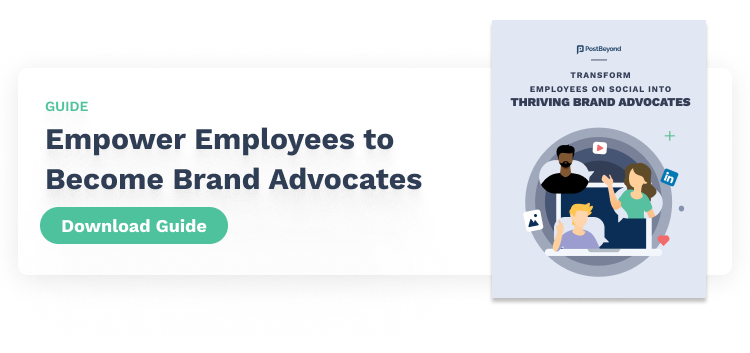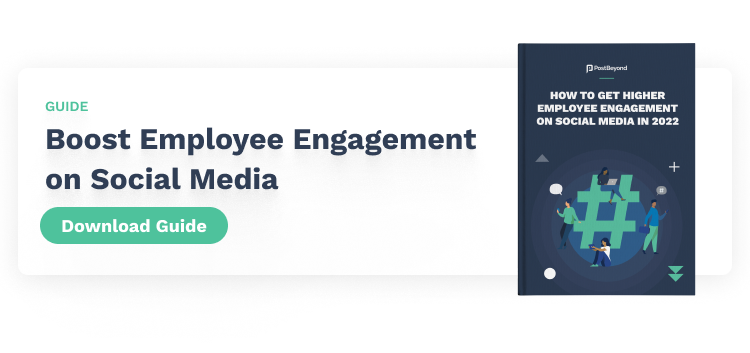Today, brands know that the word of a trusted person resonates with audiences more than an ad or official brand messaging. That “third-party validation” – as isolved’s Amberly Dressler and Hannah Litaker called it – now matters more than ever.
From job seekers looking into a potential employer, to sales prospects gauging a potential vendor, validation and the trust that comes out of it is key. You build that trust at scale with a brand advocacy strategy that leans on your employees and customers..

When we asked our webinar attendees if they tried employee advocacy, 55% of them said they heard of it, but haven’t tried yet. And of the 45% that have launched it, only 7% of them told us that they scaled their program with a lot of success.
When it came to customer advocacy, 49% of them said they were thinking about it, but don’t yet have a formalized program. 11% told us that they hadn’t even heard about it.
Clearly, building the road to a thriving brand advocacy strategy isn’t easy. We sat down with Amberly Dressler (Director of Brand & Content) and Hannah Litaker (Communications and Social Media Strategist) from isolved to unearth how they succeeded.
isolved’s employee advocacy program generated a potential reach of 5.9 million on social media and an earned media value (EMV) of $312,751.
Here’s what we learned:
Key Takeaway #1: Get Executive & Cross-Departmental Buy-In

It’s easy to say “you need executive and departmental support,” but Amberly and Hannah dug into exactly what that means and how that should work.
In isolved, executives played two key roles.
First, they championed the brand advocacy program to the company. In fact, some of them were already active on social. So, when isolved introduced a proper advocacy program, those leaders onboarded right away. They were the first to post and, in turn, encouraged the team to join.
Second, executives are critical in aligning departments to brand advocacy. isolved’s VP of Sales Enablement integrated advocacy into their team’s daily activities. This key step opened the road for isolved’s sales team to engage in advocacy as part of their jobs.
Next, link your brand advocacy with departmental goals or KPIs. Once each department sees how advocacy will support their business goals, they’ll support it.

Amberly noted how isolved’s employee advocacy program started out as a joint-venture between the marketing and HR teams. HR saw that advocacy could help them drive higher quality applicants. It also sensed that advocacy can drive higher internal engagement too.
Get the right department’s help and input. Not only are these departments stakeholders, but they’re powerful assets for delivering programs.
When isolved launched its customer advocacy program, it closely worked with the customer success (CS) and sales teams. These were customer-facing teams who understood isolved’s customers and prospects. Having their visibility and knowledge on hand was critical.
Key Takeaway #2: Curate a Diverse Array of Content

Content is a critical part of brand advocacy. However, the content needs to resonate with your advocates. When your advocates find the content interesting and speak to it, they’ll be able to land a heavier impact with their audiences.
isolved built a strong content mix by leaning on employee input. In fact, isolved really leveraged PostBeyond’s content suggestion feature to take in employee input. Employees can submit the content that interests them and the admins can curate it.
The same PostBeyond feature lets departments submit their content (like job postings by HR). isolved basically uses PostBeyond to provide employees a centralized hub to find the content they need. isolved also uses PostBeyond’s filtering and flagging tools to ensure only the right content makes it through to its employee advocates.
Key Takeaway #3: Give Back to the Advocate
Center both your employee advocacy and customer advocacy programs. You need to build a compelling answer to the question, “what’s in it for me?” Hannah emphasized that it’s critical to think about what the advocate gets from the program.
isolved saw that employee advocacy was proving to be a great vehicle for employees to build their personal branding. It’s also a way for them to grow their own networks (which also grows your brand’s reach). Finally, advocacy can help them meet departmental goals or KPIs.
Likewise, customer advocacy helps customers with both their company branding as well as their own personal branding. isolved found that its customers also wanted to stay informed about the company, its product/service roadmap, and its future plans.
Key Takeaway #4: Build Engaging Advocate Communities
Finally, Amberly and Hannah emphasized how you’ll want to move brand advocacy from “being a thing to do” to a key aspect of your company culture. When building that culture, isolved found that nurturing advocate communities were a valuable driving force.
For employees, isolved used PostBeyond as a hub for the team to stay up-to-date with the company, suggest content, and even get involved with announcements and product or service launches.
For customers, isolved built a community using Influitive. isolved’s customers were able to use Influitive to ask questions, seek guidance, and interact with other customers. This engagement empowered isolved customers to build best practices and deepen their input.
Next Steps
A key lesson we learned from isolved’s brand advocacy strategy is the importance of centering your program on your advocate. Ultimately, your advocacy program is only as strong as your advocates. You want to empower them to drive positive outcomes for both themselves and your brand.





